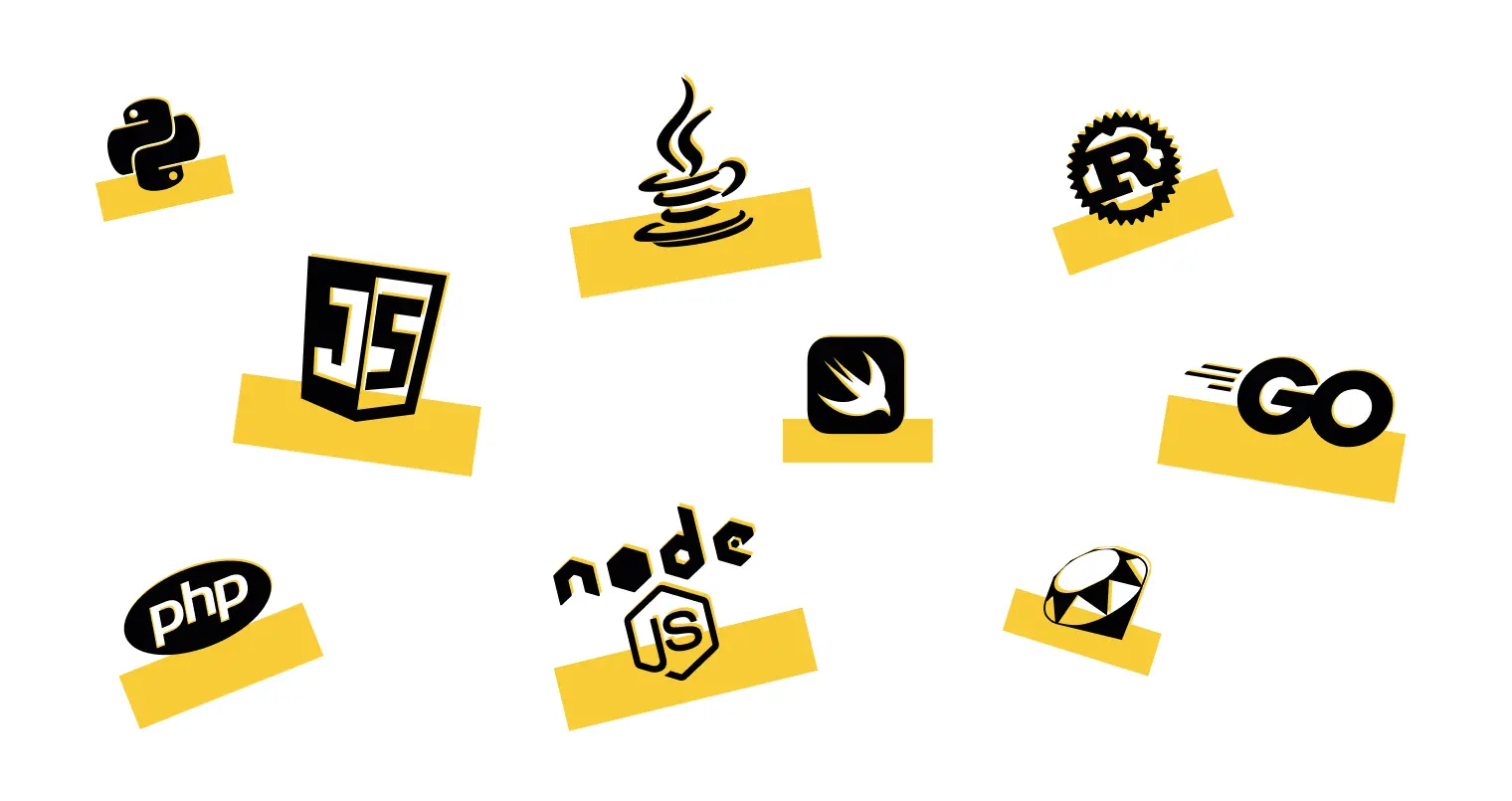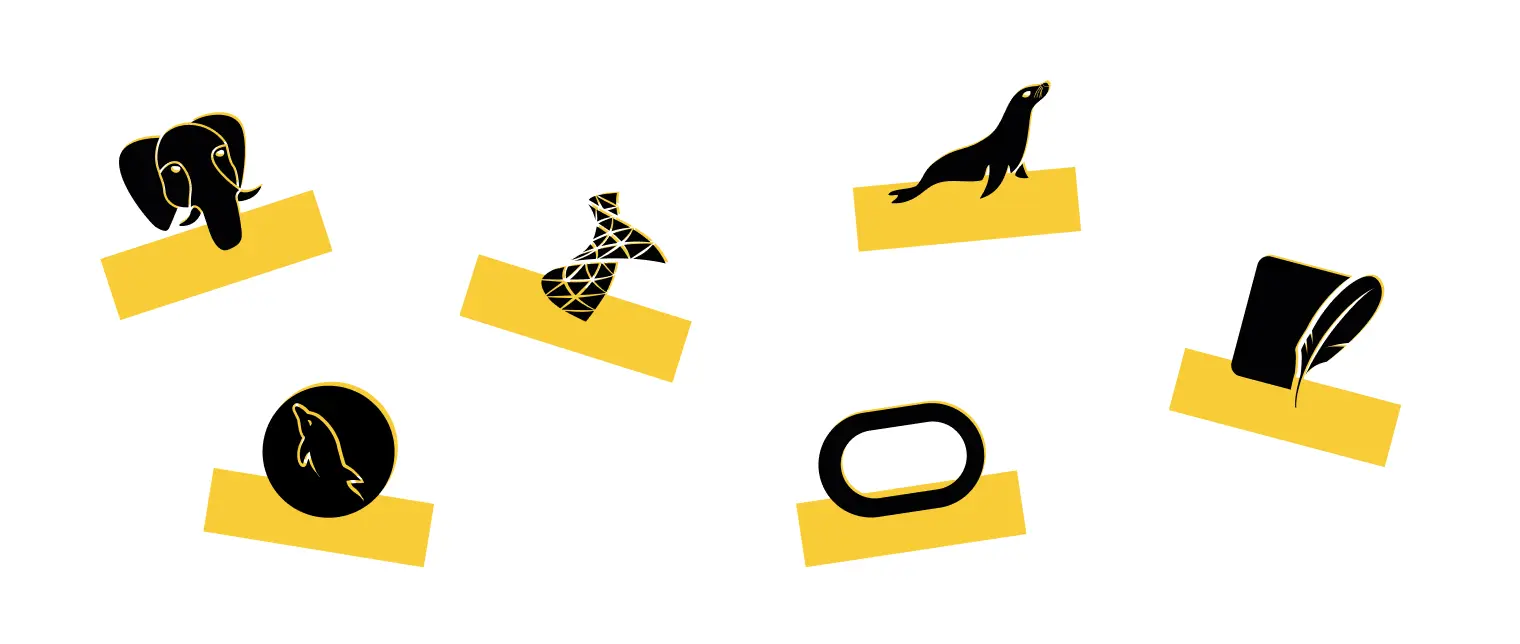Various backend technologies encompass programming languages, frameworks, databases, servers, and other development tools. According to Stack Overflow's annual developer survey in 2023, the leading languages are JavaScript (63.61%), HTML/CSS (52.97%), and Python (49.28%). The top contenders in the database category are PostgreSQL (45.55%), MySQL (41.09%), and SQLite (30.9%), while Amazon Web Services (48.62%) earned the title of the best backend technology among web services.
leading languages: JavaScript (63.61%), HTML/CSS (52.97%), and Python (49.28%).
database: PostgreSQL (45.55%), MySQL (41.09%), and SQLite (30.9%)
Lampa experts stay up-to-date with the latest mobile and web development trends. As part of our backend development services, we've compiled lists of the most in-demand languages and frameworks. We will provide detailed information on what are the backend technologies used to implement and launch reliable, secure, and successful digital projects.
What is Back-End Development?
Backend development creates the server side of a digital product responsible for handling information. It consists of three key components:
Databases: store and structure large volumes of diverse information.
Servers: computers that receive user requests and send corresponding results as determined by the application.
Applications: programs that receive user requests, process information, and respond through the server.
The backend ensures the seamless operation of mobile and web applications, various websites, and other solutions. On the server side, components such as APIs, libraries, architecture, business processes, and other system elements are written.
Back End Technologies
To delve into the field of digital product development, it is important to understand what are backend technologies. They ensure the smooth operation of digital products and establish a connection with the user interface (buttons, banners, animations) for a better user experience with the application. These technologies include programming languages, backend frameworks, databases, servers, and other tools. They are all essential for comprehensive software development, web products, and mobile programs.
Stacks
Each development team forms and selects a tech stack that meets the needs of their clients. However, there are pre-built standardized sets of best backend technologies that help in implementing various projects.
In addition to server-side technologies, they also include tools for front-end development, which is why they are also called full stacks. Let's consider the most in-demand stacks for application development and web resources.
MEAN stack
The name of this stack is an abbreviation that stands for:
MongoDB – database NoSQL.
Express.js – backend framework.
Angular – frontend framework.
Node.js – backend language.
MEAN focuses on tools based on the popular programming language JavaScript. This allows specialists to create reliable and resilient websites. By using backend development technologies from this stack, programmers can significantly speed up and streamline their work, helping you save on budget. One advantage of MEAN is that it does not require a large team of specialists to implement projects.
This stack is designed for creating various web projects, such as expense tracking and location-based apps, aggregator websites, and cloud apps. Prominent examples of MEAN usage include Reddit, Netflix, and YAHOO!
LAMP Stack
LAMP stands for:
Linux – operating system.
Apache – web server.
MySQL – database.
PHP – popular scripting language.
The tools in this stack are necessary for creating dynamic web solutions with a secure infrastructure managed by databases. In LAMP, developers can use coding languages other than PHP, such as Python and Perl, to create the backend.
This tech stack has open-source code, allowing programmers to make real-time changes. It is also flexible and easy to use, speeding up development timelines significantly.
The only downside of LAMP is that it supports only one operating system - Linux. As a result, the digital product will be available only on devices that support this OS. Examples of products built with the LAMP stack include Facebook, Wikipedia, and Tumblr.
MERN Stack
The acronym MERN stands for:
MongoDB – database NoSQL.
Express.js – backend framework.
React – frontend framework.
Node.js – backend language.
This toolset is similar to MEAN, except it uses the React framework for frontend development instead of Angular. The stack aids in the implementation of reliable and secure websites and other web products. Notable examples include GitHub, PayPal, eBay, and Bloomberg.
RoR Stack
It consists of two backend technologies for web development – the Ruby on Rails framework and the Ruby programming language. JavaScript libraries (Backbone.js, Redux, React), databases like PostgreSQL and MongoDB, and Redis database management system can be added to the stack.
RoR is an open-source backend framework that provides a wide range of tools for ensuring digital products' high security and flexibility. Web applications and mobile apps developed in Ruby and the Ruby on Rails environment are known for their performance and ability to handle large traffic volumes. Airbnb, Shopify, Twitter, Twitch, and others have been created using RoR.

Top Backend Languages
According to Gitnux, the most popular backend language in 2023 is Python. However, Java is a sought-after technology, according to Google. Additionally, 80% of Android developers prefer using Kotlin. Based on these statistics, market trends, and our expertise, Lampa's experts have compiled a list of backend languages leading in the mobile and web development industry.
1. Go (Golang)
Go (also known as Golang) is an object-oriented programming language developed by Google. It is relatively young but has already gained the trust of many professionals. Go has many backend tools that provide websites with multithreading, high performance, and computational power.
The language also features Garbage Collection for efficient memory management in programs, testing code environments, and test reporting options. As a result, it is used by many major companies, including Uber, Spotify, and YouTube.
2. Python
Python is the market leader in backend technologies. The language has a simple syntax and is easy to read, allowing for quick application development. Many beginner developers prefer it. Python has open-source code, many libraries, and auxiliary tools.
Due to its versatility, Python is used in game development, cybersecurity, and complex projects based on artificial intelligence and machine learning technologies. Companies such as Airbnb, SpaceX, Stripe, and others also prefer Python.
3. Node JS
Node.js is an open-source platform for server-side scripting. It is built on JavaScript and provides many backend tools for developing cross-platform, mobile, and web products. Using Node.js in building digital solutions ensures high security, performance, scalability, and responsiveness.
The language is also known for its ease of understanding, which positively impacts the speed of implementing large-scale projects. It is used by major companies such as Walmart, Netflix, Google, Rakuten, and more.
4. Rust
Rust is a language that integrates easily with Python, C, and C++ programs. It boasts high performance and enables writing reliable code, making it suitable for multifunctional digital products. Rust also has numerous additional tools and libraries and is compatible with frameworks like Actix, Hyper, and Rocket.
This language is used for high-load software development. The Meta corporation, for example, prefers using Rust as a backend technology for creating its network infrastructures on the Amazon Web Services (AWS) platform.
5. Java
Java is an open-source, object-oriented language used for creating the backend of a website and enterprise software. It is a flexible and reliable tool with many free libraries and frameworks, making it suitable for startups and projects of any budget.
The language supports multithreading during code writing, allowing specialists to execute multiple tasks simultaneously. All these features contribute to the accelerated and simplified programming of digital solutions. It's no surprise that giants like Google, Facebook, Uber, and Netflix rely on Java for their project development.
6. PHP
According to W3Techs statistics, 77.4% of all websites use PHP. It is an open-source scripting language for web services. With secure platforms like Joomla, Laravel, and Symfony and reusable code, professionals can significantly reduce the time spent on programming.
PHP is a flexible language that easily integrates with most other resources, which explains its popularity in the backend technologies industry. For instance, Meta developed the backend of Facebook using PHP, and Slack uses it to optimize and accelerate web request processing in their corporate application.
7. Ruby
Ruby is a flexible, high-performance, and multithreaded coding language. It features the popular Ruby on Rails framework, which assists in mobile and web application development. An additional feature of Ruby is Mixins modules, which allow for class mixing (parts of the developed program) to extend the functionality of subclasses and maintain code "cleanliness."
The Ruby on Rails framework is used by Crunchbase, eBay, Etsy, PayPal, and Bloomberg for the development and support of the backend of a website.
8. Objective-C & Swift
These are object-oriented languages used by Apple Corporation. They are designed for developing apps for iOS mobile devices. Notably, both languages can be used for frontend and backend development and are suitable for implementing programs of any complexity.

SQL databases
SQL databases, or relational databases, are tools necessary for processing information, created based on the Structured Query Language (SQL) programming language. These database management systems (DBMS) are needed for creating, structuring, storing, and retrieving data, making them among the most in-demand backend technologies.
1. PostgreSQL
PostgreSQL is a free, open-source database with a simple and convenient setup, making it popular among professional developers. This tool works with data through SQL queries and provides features for creating, storing, defining data types, and indexing. PostgreSQL is traditionally used in large-scale and industrial projects that require processing large volumes of information.
2. SQLite
SQLite is an embedded DBMS that allows adding new information, querying, and processing existing data. It is serverless and fully autonomous, providing easy setup and deployment. One characteristic of SQLite is its limited data type support, including Null, Blob, Text, Integer, and Real. Nonetheless, it is the most widely used database in the world due to its lightweight and fast performance.
3. MySQL
Backend developers widely use MySQL, which is suitable for cloud, embedded, mobile, and web applications. MySQL is characterized by enhanced security, performance, stability, and ease of use. Its support from the developer community has resulted in an extensive ecosystem of additional tools and technologies, making it easier to work with.
4. MariaDB
MariaDB is a fork of the MySQL relational database. It differentiates itself from the "parent" database by supporting data storage engines not present in MySQL, including Aria, InnoDB, Cassandra, Connect, MariaDB ColumnStore, XtraDB, and Memory. Thanks to its multiple connections and storage engines, this tool is lightweight and fast, widely used for commercial and personal purposes.
5. Oracle
Oracle, an object-relational database management system, is used in projects requiring high scalability. Oracle offers a broad range of functionality that optimizes database performance. It also provides indexing, compression, and partitioning options for easier work for backend developers. Typically, it is applied in large enterprises with extensive databases and high levels of interaction.
6. Microsoft SQL Server
Developed by Microsoft, Microsoft SQL Server is a DBMS that works well for projects targeting the Windows operating system. It offers advanced security features, support for large datasets, and high scalability. It includes additional tools such as Microsoft SQL Server Management Studio for building and managing data models and Microsoft SQL Server Data Tools for visualizing and developing the interface of database applications.

NoSQL databases
NoSQL databases are used for working with unstructured data such as images, videos, texts, and more. When compiling the back-end technologies list, we focused on their popularity and practical value in web development.
1. MongoDB
The "golden standard" of NoSQL databases, widely used for handling large volumes of data. MongoDB allows for creating document-oriented data and building complex multi-level structures and hierarchies. It has two versions: a free, open-source version and a paid Enterprise Server version with advanced functionality. MongoDB stands out for its flexibility and simplified adaptation to the requirements of each specific digital product.
2. Redis
This tool is popular among programmers and is often used with other NoSQL databases. Redis has limited functionalities that require additional modules for resolution. However, it is highly optimized for data caching and structuring. It utilizes the host's RAM for data storage, making it faster and more convenient for backend development.
3. Elasticsearch
This database is necessary for searching and analyzing logs, which are textual documents containing system or software operations records. It is typically used for monitoring processes on the backend of a website. Specialists utilize Elasticsearch as a search platform for data reporting, business analysis, and security enforcement. All of this helps create a reliable digital product with minimal risk of system failures.
4. Firebase
Firebase is a cloud-based technology that partially acts as a "backend-as-a-service." Developed by Google, it is used for storing and processing real-time data between clients. The Cloud Firestore component replicates and saves all changes to the database. Firebase also enables direct communication between the application and the database without servers.
5. Cassandra
Cassandra is a fault-tolerant distributed NoSQL database. It boasts a high level of scalability and, unlike previous NoSQL options, structures information in tables. It is predominantly used for processing and storing vast amounts of data, as it can handle high workloads. This makes it indispensable for large projects with extensive arrays of unstructured information.
Servers
As technologies used for backend development, servers play a role as the link between frontend software, apps, and other digital products.
Apache
Apache is a web server that helps transmit data over the internet and establish a connection between the frontend and backend parts of an app. This tool is free and widely used by websites worldwide. It also has open-source code and high performance, making it indispensable for various projects. Apache supports Mac OS, Windows, Novell, and others. It is most commonly used for apps based on Linux and BSD.
NGINX
NGINX is an HTTP server and reverse proxy server that forwards requests from clients (e.g., browsers) to web servers. NGINX is open-source software. It is essential for developing powerful mail and web servers that establish connections between clients and computers. Thanks to NGINX, software products achieve good performance, efficiently handling large volumes of data at high speeds.
Other
In addition to the main ones, we have highlighted additional backend technologies for web development. They are designed to facilitate the planning, development, and deployment processes of mobile and web apps and other digital projects.
1. Docker
A software platform for creating, deploying, and managing digital products. Docker as a service allows you to package developed apps or programs into containers ready for distribution. The Docker Engine program initiates its launch. The advantages of this technology include rapid deployment, security, and continuous integration.
2. Postman
A software product for creating, testing, and collaborating on API interfaces by multiple backend developers. APIs act as intermediaries between two apps to ensure smooth interaction and perform specific functions. Postman also enables the composition and processing of HTTP/s requests and responses of any complexity level. All of this speeds up the work of programmers and provides project support.
3. Jira
Software developed by Atlassian for project management and issue tracking. Jira allows for easy resolution of identified defects, demonstrating flexibility, high speed, and easy integration with third-party products. It has a wide range of functionality and developer tools that enhance productivity in working on any project.
What Back End Technologies Do We Use at Lampa?
At Lampa Software, we individually tailor the backend technologies list for each task and project. Our tech stack primarily consists of the following:
Programming languages:
Python
JavaScript
Node JS
Databases:
MySQL
PostgreSQL
MongoDB
Redis (for caching).
We also utilize proven and reliable tools such as Django, Django REST framework, Django Channels, and Nameko for backend development. Additionally, our experts employ Docker for deployment, and for cloud solutions, we leverage technologies like Amazon Web Services (AWS) and Google Cloud Platform (GCP). The deployment and launch of web applications on servers or hosting are facilitated through the use of the Jenkins software system
In our work, we practice a microservices architecture approach, which enables the deployment of each function separately. This ensures that the failure of one component does not impact the operation of the entire program, and any errors can be easily rectified. As a result, your app gains high fault tolerance and reliability.
When building backend components, we consider your business goals and digital product requirements. Therefore, depending on your needs, we offer both monolithic solutions and microservices architecture.
Conclusion
The best technology for backend development is the one that helps fully implement all the requirements of a digital project. Among the plethora of different languages, frameworks, databases, and other tools, it is important to select those that enhance specialists' productivity and ensure the release of a reliable, smoothly functioning program.
It is important to understand that selecting the right backend technology and other development tools is based on your requirements for functionality, appearance, and other product characteristics. Your business needs, goals, preferences, and budget are also considered.